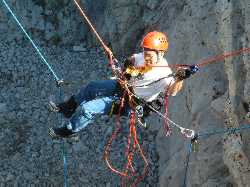ROPE ACCESS PROGRAM DESCRIPTIONS
ROPE ACCESS SKILLS WORKSHOP - LEVEL 1 (RASW-1)
-
RASW-1 ROPE ACCESS SKILLS WORKSHOP - LEVEL 1
Read (or print) the most recent color information flyer on this workshop HERE
The Rope Access Skills Workshop 1 is an intensive 5 day workshop intended specifically for those who work on rope at elevation. It is a custom contract-only workshop at this time. If the RASW-1 is offered as an "Open Enrollment" workshop, it will be seen on the Open Enrollment Schedule for any given year. The RASW-1 covers the minimum rope access essentials (for SPRAT Level 1 Technicains):
- Single and multi-point anchor building
- Descent and descent-to-ascent,
- Ascent and ascent-to-descent,
- Knot passes (ascent and descent),
- Passing deviations in ropes (ascent and descent),
- Passing intermediate anchors (rebelays),
- Rope-to-rope transfers (ascent and descent),
- Aid climbing (horizontal),
- Rescue of coworker who is descending and ascending,
- Negotiating the edge in ascent and descent mode,
- Parapet rescue or worker over the edge,
- Controlled lowers/raise
- Basic mechanical advantage
For full list of RASW-1 covered topics, see "RASW-1 Key Points" above.
For the RASW-1, the principle RTR instructor is Keith Thorne.
About the RASW-1 Instructor:
Keith Thorne is Reed and Jayne Thorne's middle son (born 1990). He is a regular assistant co-instructor with his father, Reed, and travels extensively around the United States, Canada, Australia, England/Scotland, Japan and anyplace else were he can assist in rope rescue or rigging classes for Ropes That Rescue. Known as a true critical thinker, he prides his ability to think outside the box with the students. Keith is a regular co-instructor along with his brother, Luke. The two boys love teaching rigging at RTR programs and regularly accompany each other in climbing, mountain biking, camping, hiking and anything to do with the backcountry. Keith has taken up the guitar and loves reading as a pastime. He and sister, Arianna Rose (born 1993), also enjoy acro yoga (acrobatic yoga) whenever they are together. He also loves working out with weights, resistance bands and in a devotee to the P90X regimen.Professional Accomplishments:
Keith has also certified as a rope access technician supervisor Level 3 with the Society of Professional Rope Access Technicians (SPRAT) and has supervised rope access jobs on wind turbines, bridges and hydroelectric dams throughout the USA for Abseilon in Phoenix. Keith has also worked both in Saudi Arabia for Arabian Rope Services and in Queensland, Australia with Rob Stringer and his rope access company, Highpoint Access and Rescue.In 2020, Keith competed with two friends (Both RTR alumni) in the North American Petzl North American ROPE TRIP in Salt Lake City, Utah where they took first place honors for Abseilon. They were slated to then compete in the 2021 Petzl Rope Trip World Championships in Singapore but that was unfortunately cancelled due to the worldwide pandemic.
Rope access is used around the world to support or place workers in various environments for the purpose of performing their jobs. This may include, but is not limited to:
- Bridge, dam or structural inspectors
- High scalers
- Construction personnel
- Sea platform inspection and construction
- Tower workers
The RASW-1 is entry level and provides training needed for the Society of Professional Rope Access Technician (SPRAT) Level 1, 2 and 3 certifications.
-
RASW-1 Key Points
KEY POINTS
Read (or print) the most recent color information flyer on this workshop HERE
- Job site safety!
- Applicable federal and state laws on rope access
- Knotcraft for rope access work: end line, middle, hitches, bends
- Rope access rope and equipment, inspection and care
- Rope management
- Job site evaluation and rigging for safe working conditions
- Two-point contact principles (main/belay)
- Rope access equipment:
- Descenders /ascenders
- Connectors / carabiners / screw links
- Fall arrest, work positioning
- Helmets, PPE, harnesses, other...
- Lanyards
- Beginning pulley systems
- Complete use of AZTEK kit
- Belaying (safety line) techniques and communication
- True belays
- Self belays
- Anchoring principles
- Distributing
- Multipoint
- Fixed and focused
- Bolts / hangers
- Improvised and manufactures lanyards and slings
- Minimum rope access essentials:
- Descent and descent-to-ascent
- Ascent and ascent-to-descent
- Knot passes (ascent and descent)
- Passing deviations in ropes (ascent and descent)
- Passing intermediate anchors (rebelays)
- Rope-to-rope transfers (ascent and descent)
- Aid climbing (horizontal)
- Rescue of coworker who is descending and ascending
- Negotiating the edge in ascent and descent mode
- Parapet rescue or worker over the edge
- Controlled lowers/raise
- Hazard analysis and risk assessment
- Communication
- Much more
-
RASW-1 Details
5 Days6 Students Max/1 InstructorModerately difficultClassroom 20%, Practicals 80%For the reuired Equipment for this program contact us HERE.
Read (or print) the most recent color information flyer on this workshop HERE
Seventh day SPRAT evaluation is optional (if offered). SPRAT test fee and SPRAT Evalauator fees are NOT included in RASW-1 tuition.
Prerequisites: You must be in good physical condition to participate in this workshop.
Get: RTR Application
Go to: Regstration Information
Find out tuition and next program (if offered as Open Enrollment): See Schedule -
RASW-1 Photos
ROPE ACCESS SKILLS WORKSHOP PHOTOS
From Ropes That Recue collection. All photos copyright RTR ©1999/2022Read (or print) the most recent color information flyer on this workshop HERE
Engineer for Grand Coulee Dam using rope access techniques for US BUREAU OF RECLAMATION during on site Ropes That Rescue rope access program
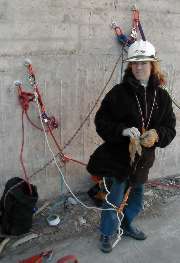
Important rope access anchoring techniques are covered extensively. RTR's Jayne Thorne getting ready to call it a day after dam inspection
Becky Cordova lead climbing on 730' high Forest Hill Bridge near Auburn, CA.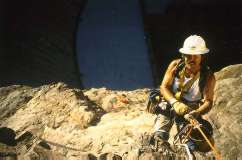
Reed Thorne at Hoover in 1997 installing seismic monitoring devices for USBR. Photo: Jayne Thorne -
RASW-1 Equipment List
ROPE ACCESS SKILLS WORKSHOP - LEVEL 2 (RASW-2)
-
RASW-2
Read (or print) the most recent color information flyer on this workshop HERE
The Rope Access Skills Workshop 2 is the next level beyond SPRAT Level 1. It teachs the techniques needed to certify at SPRAT Level 2 or 3. This program also goes well beyond these levels and teaches many rescue technques not found in the SPRAT Safe Work Practices and Certification Guidelines.
See the RASW-2 "Key Points" above for a deatailed list of what this program covers.
About the RASW-2 Instructor:
Keith Thorne is Reed and Jayne Thorne's middle son (born 1990). He is a regular assistant co-instructor with his father, Reed, and travels extensively around the United States, Canada, Australia, England/Scotland, Japan and anyplace else were he can assist in rope rescue or rigging classes for Ropes That Rescue. Known as a true critical thinker, he prides his ability to think outside the box with the students. Keith is a regular co-instructor along with his brother, Luke. The two boys love teaching rigging at RTR programs and regularly accompany each other in climbing, mountain biking, camping, hiking and anything to do with the backcountry. Keith has taken up the guitar and loves reading as a pastime. He and sister, Arianna Rose (born 1993), also enjoy acro yoga (acrobatic yoga) whenever they are together. He also loves working out with weights, resistance bands and in a devotee to the P90X regimen. Professional Accomplishments:
Keith has also certified as a rope access technician supervisor Level 3 with the Society of Professional Rope Access Technicians (SPRAT) and has supervised rope access jobs on wind turbines, bridges and hydroelectric dams throughout the USA for Abseilon in Phoenix. Keith has also worked both in Saudi Arabia for Arabian Rope Services and in Queensland, Australia with Rob Stringer and his rope access company, Highpoint Access and Rescue.In 2020, Keith competed with two friends (Both RTR alumni) in the North American Petzl North American ROPE TRIP in Salt Lake City, Utah where they took first place honors for Abseilon. They were slated to then compete in the 2021 Petzl Rope Trip World Championships in Singapore but that was unfortunately cancelled due to the worldwide pandemic.
Ideal for:
- Those SPRAT Level 1 technicians wishing to prepare for Level 2.
- Those SPRAT Level 2 technicians wishing to prepare for Level 3.
- Fire fighters or emergency personnel wishing to gain rope access skills (with option not to certify)
The RASW-2 is 5 days long (five additional days above the five days in length for the RASW-1)
-
RASW-2 Key Points
RASW-2 Key Points:
Read (or print) the most recent color information flyer on this workshop HERE
- Ideal for advanced SPRAT L-1 rope access technicians (who are moving up)
- Strong emphasis on advanced personal rope access skills
- Many rescue techniques
- Anchor building using rock pro (active and passive)
- Anchor building using piton family (if available)
- Backtying and oppositon (front ties) and general rigging for anchoring
- Critical analysis of multi-point anchoring systems (understanding physics)
- Rope coiling methods
- Rope management to eliminate snarls and frustration
- Improvisation and minimalism "What do you do if the gadget does not show up?"
- Knotcraft to the extreme (There is a strong emphasis on knot skills)
- Advanced to pulley systems (partial lecture)
- Multiple methods of descending on rope (including improvised)
- Multiple methods of ascending on handled ascenders
- Passing knots on ascent and descent with a casualty in tow
- Rope-to-rope transfers
on ascent and descent with a casualty in tow - Passing re-belays on ascent and descent
with a casualty in tow - Passing standard deviations against wall
on ascent and descent with a casualty in tow - Passing "flying" deviations (no wall) on ascent and descent
with a casualty in tow - Horizontal and sloping up or down aid climbing
- True belays and self belays
- Self rescue techniques / Buddy rescue techniques
- AZTEK kit orientation for personal and team operations:
- First 8 uses of AZTEK
- Single and double part hasty rappels (5 & 6)
- Belays and self belays (3 & 4)
- Dynamic fixed and traveling brakes
- Ascending with AZTEK in 2 parts (7)
- Personal travel restrict (1 & 2)
- Set of fours pulley system (8)
- Solo rescue: Complete Seven Minimalist Rescue Archetypes (7MRA)
- Solo rescuer pick off ("gecko" and hanging)
- Semi-solo rescuer pick offs ("gecko" and hanging)
Solo one-on-one rescues: - Pitch head rescue (breaking into lines on top with AZTEK and bringing casualty up from bottom)
- Pitch toe rescue (descending to bottom and attaching to casualty with AZTEK and ascending with them to top)
- Counter balance rescue (if time permists)(Using your own weight to advance someone up a cliff or drop)
- Lead climbing (optional)
- Sound anchoring principles: simple through advanced system anchors
- Rigging plates and pods using AZ Vortex, focused floating anchors made "bombproof" for over edge rope work
- Manual and auto stop friction appliances
- Much more....
-
RASW-2 Details
5 Days6 Students Max/1 InstructorModerately difficultClassroom 20%, Practicals 80%Read (or print) the most recent color information flyer on this workshop HERERASW-2 is not offered each year on the Open Enrollment ScheduleRequired Rope Access Equipment
Prerequisites: RASW-1 or special permission.
Get: RTR Application
Go to: Regstration Information -
RASW-2 Photos
ROPE ACCESS SKILLS WORKSHOP PHOTOS
From Ropes That Recue collection. All photos copyright RTR ©1999/2022Read (or print) the most recent color information flyer on this workshop HERE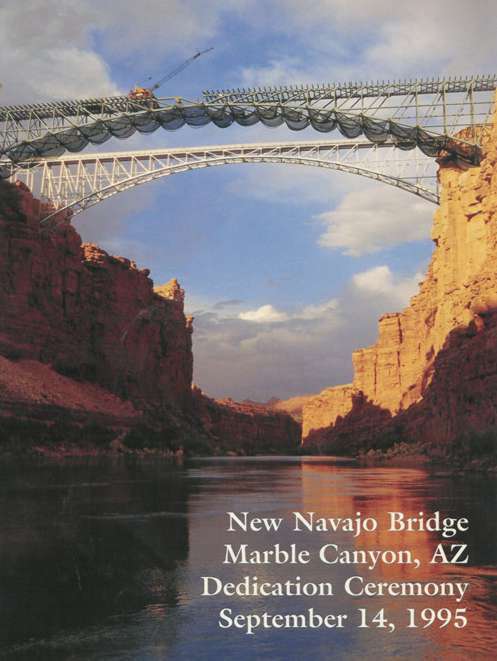
Ropes That Rescue has been contracted to train and supervise high scaling crews for contractors and the Arizona Dept. of Transportation (ADOT). They have designed safe two-rope systems for scalers involved in difficult high scaling operations. RTR riggers are masters at complex scaling anchors and rigging requiring in various rock types including expansion bolts, epoxy bolts and other unique problems relative to multi-rope scaling systems. Two separate safety awards were awarded to teams that were trained and managed by Ropes That Rescue, including the Navajo Bridge rope inspection team for ADOT (see below). This high arch bridge spans the Colorado River in Marble Canyon and was completed in 1995.
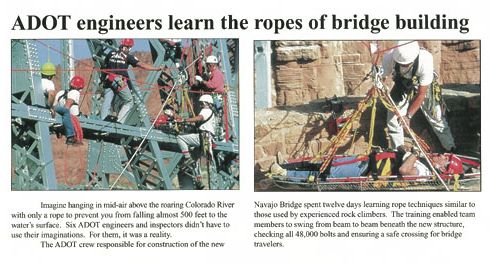
Navajo Bridge nears completion.
Above, RTR working with ADOT on advanced rescue techniques involving highline to canyon wall from center of bridge.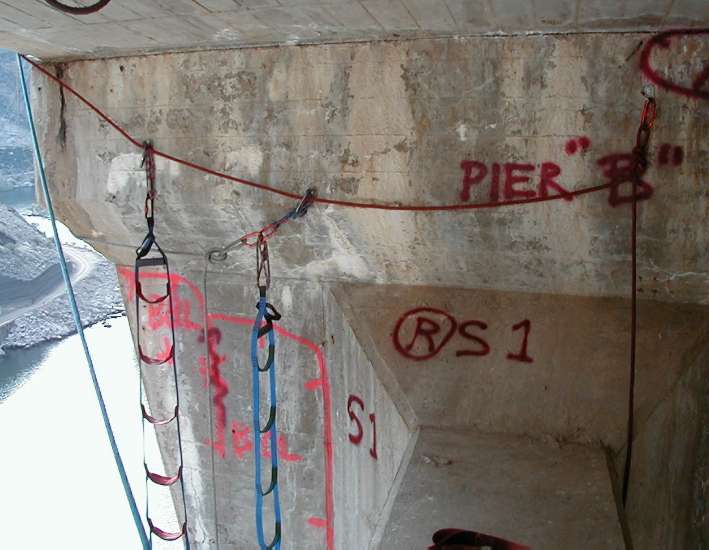
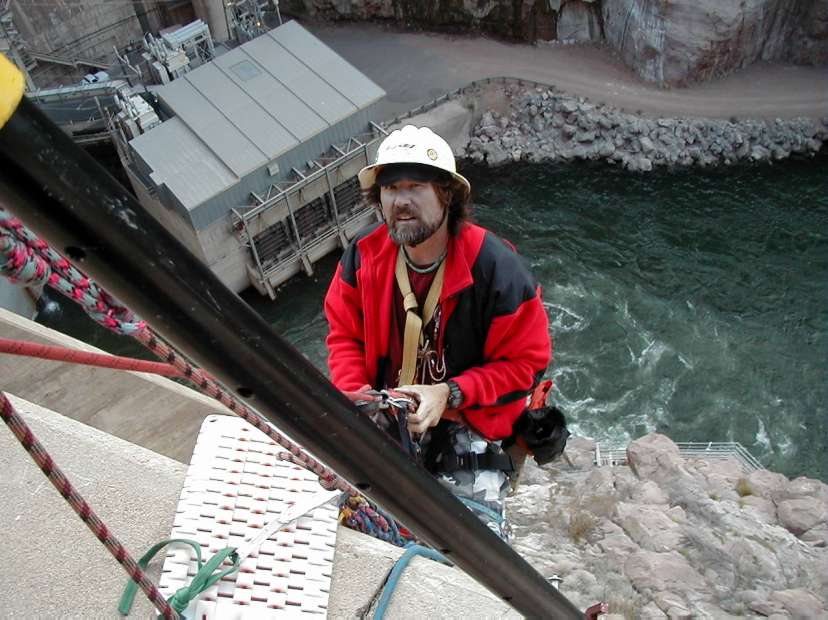
A complete inspection using rope access techniques on the Horse Mesa Dam spillway for Salt River Project in December, 2001.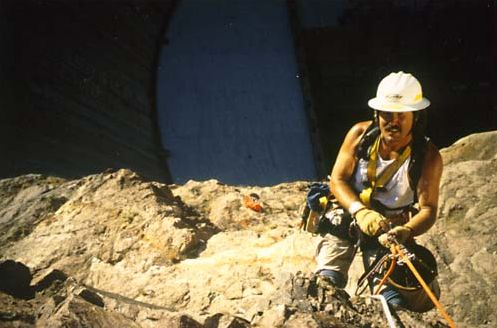
Reed Thorne on descent above Hoover Dam powerhouse.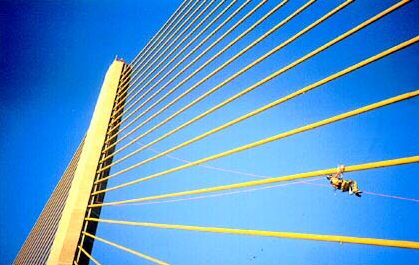
RTR at the Tampa Bay SUNSET SKYWAY bridge for Florida DOT inspection 1998. Special rope access equipment was designed by RTR for this difficult inspection.
-
RASW-2 Equipment List
ROPE ACCESS SYSTEMS INTENSIVE (RASI)
-
Rope Access Systems INTENSIVE
Read (or print) the most recent color information flyer on this workshop HERE
The Rope Access System INTENSIVE (RASI) is an "intensive" 5 day long open enrollment (when offered - see latest Schedule) and custom contract workshop intended specifically for those rope access technicians or supervisors wishing to obtain and demonstrate more depth of understanding in multi-faceted and complex rope systems used in rope "disciplines" of any kind.
The RASI therefore is more classroom oriented and yet therefore perfect for SPRAT level 3 supervisors or others running complex rope access jobs. It dramatically differs from the on-rope intensive RASW-1 and RASW-2 in scope in that there is very little "on-rope" access skills. After the comprehensively-illustrated media presentations and in-class lecture, students take to the field with outdoor demonstration of learned principles. These would includes skillsets involving around artificial high directionals, or AHD's (tripods, bipods and monopods), back from the edge rigging pods, bipods and tripods, anchoring jamb poles and alternate anchoring methods using the Arizona Vortex or other manufactured frames, mechanical advantage (tensioning, lifting and moving equipment with pulley systems), advanced anchoring analysis, and high angle "offsetting" involving 1) tag lines, 2) guiding lines, 3) tracking lines, 4) skate blocks, 5) deflecting lines and 6) two rope pendulums). There is also a session on the use of mechanical capstan winches for raising and lowerings loads. EQUIPMENT FOR THIS PROGRAM: Required personal equipment for this program may vary widely according to the venues. Contact RTR for more information. Minimally, you will need personal PPE, harness, helmet, AZTEK or personal travel restrict system of your choosing, gloves and inclement weather clothing/thermal protection. If the RASI is an "Open Enrollment" program (see schedule) offered in Jerome, Arizona, all team equipment, (Gear, Vortex's and rope) will be supplied. If a custom contract program, this will need to be supplied by the customer. Contact RTR for more information. About the Instructor(s):
- Reed Thorne is the senior lead instructor for Ropes That Rescue in Arizona and is well versed in teaching advanced rigging through the many programs offered.
Reed was an early participant in rope access before the term became well established. He practices rope access procedures often on his back yard training and testing tower. His services through Ropes That Rescue have been required on several dams and bridges throughout the Southwest including work on Salt River Project hydro dams and also Hoover Dam along with Jayne Thorne, Reed's wife. The Arizona Department of Transportation structural engineers were taught by RTR during the construction of Navajo Bridge over Marble Canyon in 1995. His work with various construction companies such as Edward Kraemer and Sons, Kiewitt Western and Vasco Company have earned him a reputation as a knowledgeable technical rigger where understanding and safety are of paramount concern. He also teaches the Advanced Anchoring Analysis & Beyond the Barn Floor Seminars which are two advanced mathematics-oriented analysis ‘seminars’ and are vastly different from any other that RTR offers as there is no over the edge nor on-rope activities. See the AAA-BTBF slide show HERE (scroll down to bottom) Keith Thorne is Reed and Jayne Thorne's middle son (born 1990). He is a regular assistant co-instructor with his father, Reed, and travels extensively around the United States, Canada, Australia, England/Scotland, Japan and anyplace else were he can assist in rope rescue or rigging classes for Ropes That Rescue. Known as a true critical thinker, he prides his ability to think outside the box with the students. Keith is a regular co-instructor along with his brother, Luke. The two boys love teaching rigging at RTR programs and regularly accompany each other in climbing, mountain biking, camping, hiking and anything to do with the backcountry. Keith has taken up the guitar and loves reading as a pastime. He and sister, Arianna Rose (born 1993), also enjoy acro-yoga (acrobatic yoga) whenever they are together. He also loves working out with weights, resistance bands and in a devotee to the P90X regimen.
Keith's Professional Accomplishments:
Keith has also certified as a rope access technician supervisor Level 3 with the Society of Professional Rope Access Technicians (SPRAT) and has supervised rope access jobs on wind turbines, bridges and hydroelectric dams throughout the USA for Abseilon in Phoenix. Keith has also worked both in Saudi Arabia for Arabian Rope Services and in Queensland, Australia with Rob Stringer and his rope access company, Highpoint Access and Rescue.In 2020, Keith competed with two friends (Both RTR alumni) in the North American Petzl North American ROPE TRIP in Salt Lake City, Utah where they took first place honors for Abseilon. They were slated to then compete in the 2021 Petzl Rope Trip World Championships in Singapore but that was unfortunately cancelled due to the worldwide pandemic.
There are NO prerequisites for this program.
Rope Access Systems INTENSIVE: Ideal for:
- Job supervisors
- SPRAT Level 3 Rope Access Technicians
- SPRAT Evaluators
- Theater and stage riggers
- SPRAT Level 1 or Level 2 Technicians who wish to increase their personal understand to improve their job performance
- Fire fighters who want a compact 5 day review of rescue systems in a benign setting where the AZ Vortex, offsets, anchoring are all reviewed at a place where exposure is limited.
The RASI is 5 days long. No on-rope skills needed during this program. Nothing at elevation, however fall protection along with harness, helmet and basic PPE will be needed.
- Reed Thorne is the senior lead instructor for Ropes That Rescue in Arizona and is well versed in teaching advanced rigging through the many programs offered.
-
RASI Key Points
NOTE: Each RASI is different and will be directed as to student needs concerning high directional frame use, anchoring and much much more.
Read (or print) the most recent color information flyer on this workshop HERE
- Safety factors / Safety margins (need calculator)
- Whiteboard analysis of systems
- Classroom lecture and then to the field for practical demonstrations and building of systems leading to competency
- Strong emphasis on understanding of simple to complex rigging skills
- Knotcraft (for advanced rigging) Understanding knots, bends and hitches
- Anchoring principles (Marginal, substantial and "bombproof") intermediate through advanced system anchors
- Intermediate pulley systems (simple, compound and complex)
- Physics of rope rescue (force vectors and their applications to rigging)
- Two tensioned rope systems analysis
- Artificial high directions (AHD's or frames):
- Jamb poles
- A-frames (bipods)
- Sideways A-frames (In-line A-frame bipod)
- Easel A-frames
(un-equal sided tripod) - Tripids (equal sided tripod)
- Directionals and anchor angle force calculations
- Back for the edge focused and focused-floating anchors:
- Rigging pods
- Rigging bipods
- Rigging tripods
- High Angle Offsets:
- Tag and guiding line offsets
- Deflected offsets
- Tracking line offsets
- Skate block offsets
- Two rope offsets
- Much more....
-
RASI Details
5 Days12 Students Max/1 InstructorEasyClassroom 50%, Practicals 50%Read (or print) the most recent color information flyer on this workshop HERE
NOTE: Required personal equipment for this program may vary widely according to the venues. Contact RTR for more informtion. Minimally, you will need persopnal PPE, harness, helmet, AZTEK gloves and other items.
If thils RASI is an "Open Enrollment" program offered in Jerome, Arizona, all team equipment, (Gear, Vortex's and rope) will be supplied. If a custom contract program, this will need to be supplied by the customer.Contact RTR for more informtion. Prerequisites: NONE
Get: RTR Application
Go to: Regstration Information
Find out tuition and next program (if offered as Open Enrollment): See ScheduleGo HERE for AZTEK instructions.
-
RASI Photos
ROPE ACCESS SYSTEMS INTENSIVE PHOTOS
From Ropes That Recue collection. All photos copyright RTR ©1999/2022Read (or print) the most recent color information flyer on this workshop HERE

Ropes That Rescue has been contracted to train and supervise high scaling crews for contractors and the Arizona Dept. of Transportation (ADOT). They have designed safe two-rope systems for scalers involved in difficult high scaling operations. RTR riggers are masters at complex scaling anchors and rigging requiring in various rock types including expansion bolts, epoxy bolts and other unique problems relative to multi-rope scaling systems. Two separate safety awards were awarded to teams that were trained and managed by Ropes That Rescue, including the Navajo Bridge rope inspection team for ADOT (see below). This high arch bridge spans the Colorado River in Marble Canyon and was completed in 1995. 
Navajo Bridge nears completion.
Above, RTR working with ADOT on advanced rescue techniques involving highline to canyon wall from center of bridge.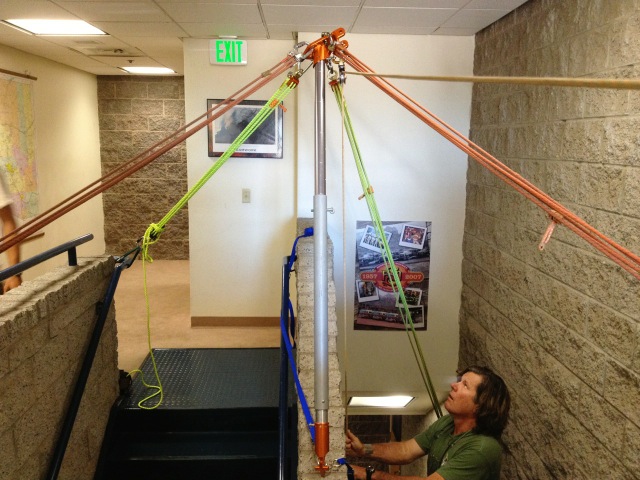
RTR Senior Lead Instructor, Reed Thorne, explaining the physics of a quad guyed gin pole using the Arziona Vortex in a fire department stari well.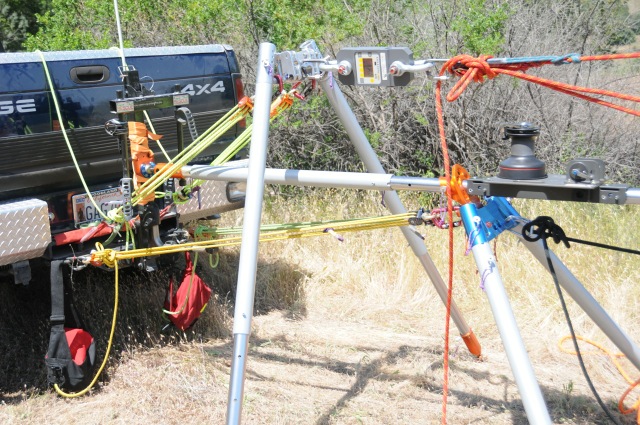
An Arixzona Vortex 2 frame set up using the back of a Dodge pickup truck as an anchor. The lower tripod is a capstan winch stand used for tensioning and transporting materials and personnel cross a long span.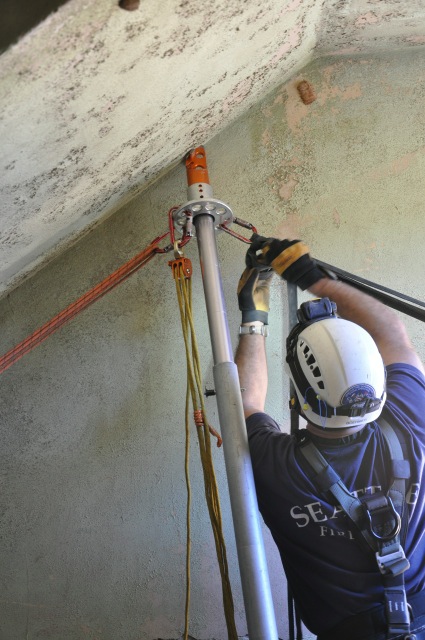
Jamb poles used extensively in the RASI program for alternative anchoring.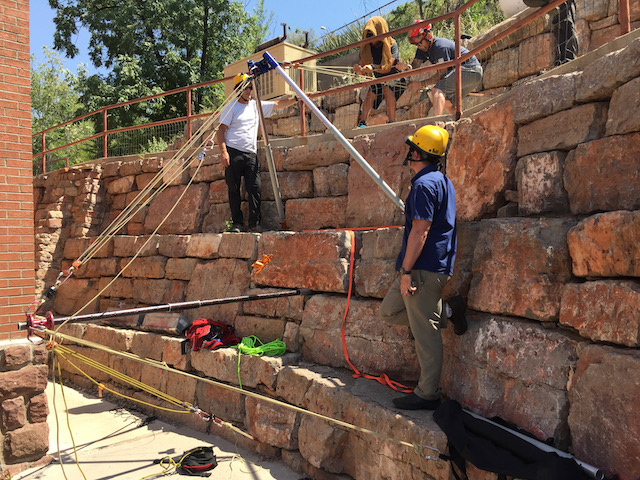
Students working with guy angle loading comparisons with the Arizona Vortex at the Jerome Fire Station in historic copper mining town of Jerome, AZ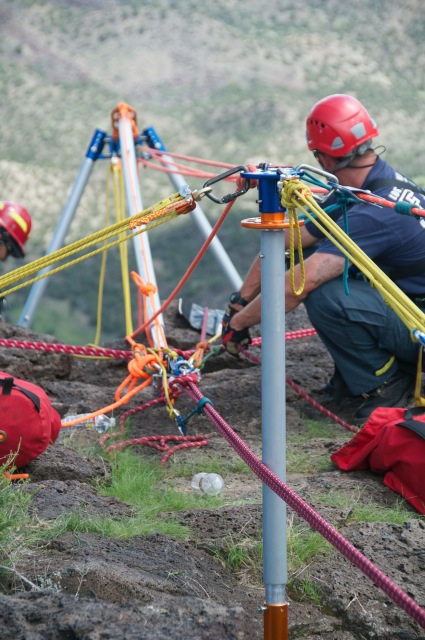
The Arizona Vortex used both at the edge (see beyond tripod) and also back from the edge (see rigging pod) are common in the RASi.
The use of High Angle Offsets (here a defelction line offet) with second rope belays or safety lines.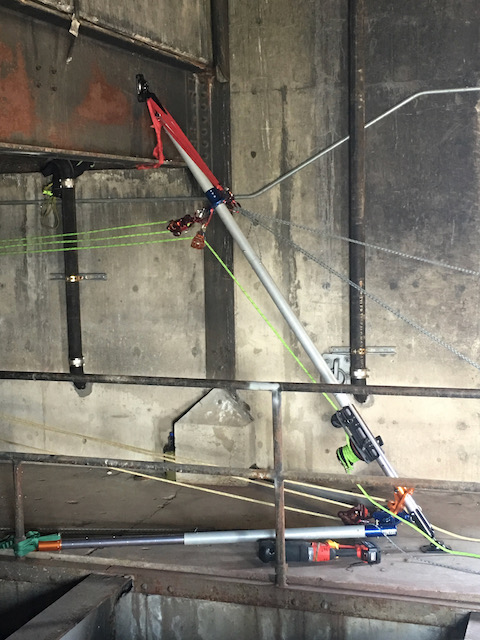
The Arizona Vortex used as a back from the edge rigging tripod and jamb pole employing the SkyHook® capstan winch.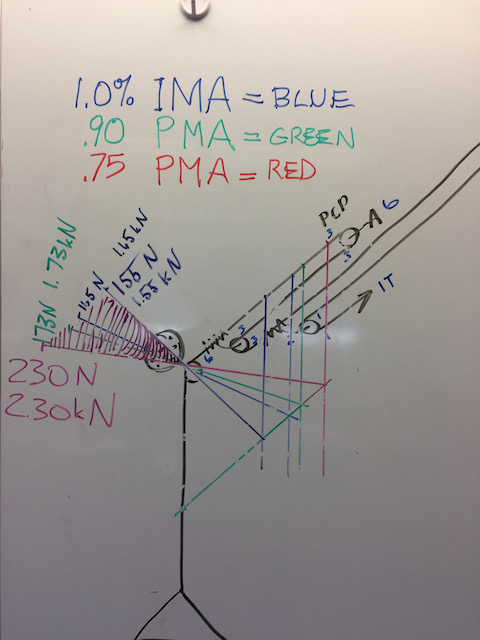
Extensive whitebaord analysis in the Rope Access Systems Intensive program. -
RASI Equipment List


